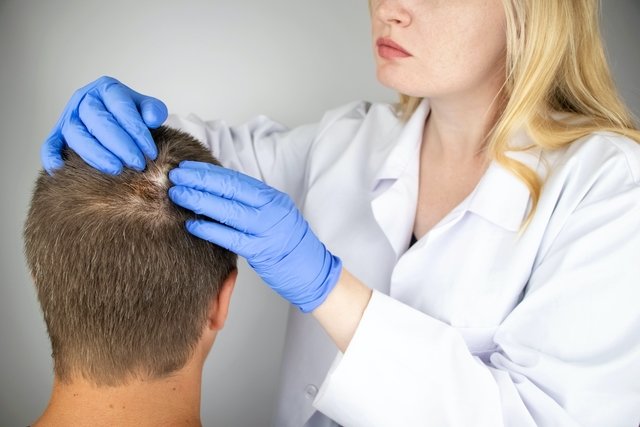Seborrheic dermatitis is a common inflammation of the skin that mainly affects the scalp. It can also occur on oily areas of the skin such as the sides of the nose, ears, beard, eyelids, eyebrows and chest. This condition is associated with symptoms such as redness, spots and peeling skin.
Seborrheic dermatitis, also known as dandruff, seborrheic psoriasis or seborrheic eczema, is not contagious, and is very common in babies in the first months of life. It usually disappears within a year without the need for treatment. However, in adults, seborrheic dermatitis is a chronic condition, and presents as periods of improvement and worsening.
Therefore, if you experience symptoms of seborrheic dermatitis, it is important to consult a dermatologist, as in some cases it may be necessary to use specific shampoos or antifungals.

Main symptoms
Seborrheic dermatitis can appear in babies or adults, and may symptoms like:
- Dandruff on the scalp, eyebrows, beard or mustache, with the formation of small, thin flakes of dead skin that can be visible on dark clothes or to the naked eye
- Spots or plaques with yellowish or whitish crusts on the scalp, face, sides of the nose, eyebrows, ears, eyelids or chest
- Redness and swelling of the skin in the affected region
- Itching in the affected regions
These symptoms may worsen in stressful situations or when the skin is exposed to cold, dry environments.
In more serious cases, the spots on the skin can thicken and become yellow and greasy. This can also lead to an increased risk for developing infections.
Also recommended: Perioral Dermatitis: Symptoms (with Online Quiz), Causes & Treatment tuasaude.com/en/perioral-dermatitsOnline symptom test
Seborrheic dermatitis is a type of dermatitis, like atopic dermatitis and contact dermatitis. To determine your risk for having dermatitis, report your symptoms below:
Note that this quiz is only a guidance tool and does not confirm a diagnosis or replace a consultation with a dermatologist or general practitioner.
Confirming a diagnosis
A seborrheic dermatitis diagnosis is confirmed by a dermatologist, mainly by evaluating the presenting symptoms. The doctor should also take other factors into consideration, such as the health history, the frequency with which symptoms appear and what can trigger or worsen them (e.g. stress or anxiety).
The doctor may also order a skin scraping test, which consists of removing some skin cells and analyzing them under a microscope. This is done to rule out other skin problems that can cause similar symptoms, such as psoriasis, eczema or rosacea.
Also recommended: Psoriasis: Symptoms, 10 Types, Causes & Treatment Options tuasaude.com/en/psoriasisPossible causes
It is not known what causes seborrheic dermatitis, but it appears to be related to the Malassezia fungus. It may be present in oily secretions of the skin, and can appear as an irregular immune response.
Furthermore, there are factors that can increase the risk for developing this condition, such as neurological diseases like depression or Parkinson's, the use of medications, stress, or a weakened immune system, due to organ transplantation, HIV infection or cancer.
Treatment options
Seborrheic dermatitis can improve without the need for treatment, however, in some cases it may not be curable and may flare-up several times throughout a life time. In these cases, the dermatologist may recommend the use of some medications to help control skin inflammation, such as:
- Corticosteroids in the form of shampoos, creams or ointments, such as hydrocortisone, fluocinolone, clobetasol or desonide, which are applied directly to the scalp or affected skin area. These products must be used with great care and for the duration prescribed by the doctor, without exceeding it.
- Immunosuppressants in the form of creams or lotions, such as tacrolimus or pimecrolimus, applied directly to the affected region.
- Antifungals in the form of ointment, gel, cream or shampoo, such as ketoconazole or ciclopirox, applied directly to the affected region.
Additionally, if topical medications are not effective or if symptoms return, it may be necessary to take oral antifungal medication.
Also recommended: Seborrheic Dermatitis Treatment: Shampoos, Ointments & More tuasaude.com/en/seborrheic-dermatitis-treatmentFor the treatment to be more successful, it is very important to always keep your hair and scalp clean and dry, to remove shampoo and conditioner thoroughly after showering, and to avoid using very hot water.
You should also reduce your intake of alcohol and fatty foods. Read more about the dermatitis diet your doctor may recommend.
Seborrheic dermatitis in babies
In babies, seborrheic dermatitis disappears on its own after a few months. It is recommended to wash the baby's hair with water and a neutral pH shampoo that is suitable for babies. After bathing, comb the scalp with a soft bristle brush to remove any dry crusts. If the scabs do not come off easily, you can apply a small amount of mineral oil or Vaseline to the baby's scalp, leave it on for a few minutes and then remove with a brush or comb.
Additionally, your pediatrician may recommend the use of a cortisone cream, such as 1% hydrocortisone. After the baby's symptoms improve, the pediatrician may recommend that regular baby shampoo be used again.
In the case of seborrhea in other parts of the body, the pediatrician may also recommend the use of creams that contain steroids or antifungals.
Home remedies
A great home remedy for the treatment of seborrheic dermatitis is tea tree oil. It contains antibacterial, healing and antifungal properties, that can be applied directly to the affected areas. It should ideally be diluted in another vegetable oil, to avoid skin reactions.
Aloe vera is also a great option for eliminating dandruff, as it contains enzymes that eliminate dead cells. It can be used as a cream or gel, or the plant can be applied directly to the skin. Read more about the health benefits of aloe vera for the hair and how to use it.
